Mill Hill: A History of Old West Durham
Pin Hook
Located near Duke's East Campus and Ninth Street, Old West Durham is one of the oldest neighborhoods in the Bull City. Previously known as Pin Hook, the area was settled before Durham itself.
Pin Hook began as a tiny settlement that served as a traveler's rest before the railroad town of Durham was established in the early 1850s. Pin Hookers were folks who bought tobacco leaf that went unsold at auction, repackaged the product, and sold it for a tiny profit. Jean Anderson provides wonderful accounts of Pin Hook in her outstanding book on Durham history... In the early days, the shiftless of society, usually addicted to vices of one sort or another, tended to congregate in Pin Hook, attracting others of their kind.
The settlement included a lodging house, camping grove, brothels, grog shops, and a well for drinking water for passing travelers. In spite of the dirt and noise caused by the railroad that ran through Pin Hook, people gradually settled near the Hillsborough Road with its easy access to Durham.
A story in the Hillsborough newspaper in 1871 described the early character of the neighborhood. "There is a place called Pin Hook... and it is remarkable for a race that was run there many years ago by a man and a woman. They wore no clothes and ran for a quart of liquor."
Because of Pin Hook's harsh reputation, Meredith College decided not to locate in the area. And, Trinity College almost decided to go elsewhere. It was not until the early 1890s, and the building of the Erwin Cotton Mills that Pin Hook would transform itself into the mill village of West Durham.

Erwin Cotton Mills
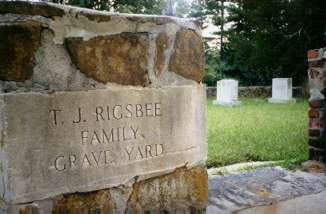
Throughout the 19th century, much of the area around Pin Hook was farmland. According to the Herald-Sun, the Rigsbee family farm stretched 600 acres -- including the Ninth Street area. For one hundred years, the Rigsbees raised tobacco, corn, and sweet potatoes on the hills south of Old West Durham. They kept their pigs down in a ravine. In 1892, the Rigsbees sold a northern section of their land for the construction of Erwin Mills. 33 years later, they sold their holdings for a new university. That land is now called Duke's West Campus. And the ravine where the pigs were kept is now called Wallace Wade Stadium (site of the 1942 Rose Bowl -- moved to Durham due to fears of having large crowds on the west coast after Pearl Harbor). Today, you can still see the small Rigsbee family cemetery -- surrounded by a low, Duke stone wall and the football stadium parking lot.
As you walk down Ninth Street today, the long red brick building across from the Regulator Bookshop seems to be an almost forgotten footnote of history. And yet the Erwin Cotton Mills were the driving force that made Old West Durham what it is today. Durham County by Jean Anderson and The Durham Architectural And Historic Inventory (Historic Preservation Society of Durham) offer outstanding accounts of the impact Erwin Mills would have on the neighborhood. According to Anderson, the new company bought several adjacent tracts of land in West Durham and built a brick factory 75 by 347 feet, two stories high, with a picker building, dyehouse, boiler room, and engine house. Rows of neat houses were built for the workers, who in 1895 numbered 375. The factory then had 11,000 spindles and 360 looms producing fine muslin, chambrays, camlets, and denims.
Paul Bonner writes in the Herald-Sun that the steady noise of the mills reverberated throughout the surrounding village -- and so pervaded the workers' consciousness that they noticed it only when it ceased, making Sundays seem unnaturally still. Company housing was modest and decent by the standards of the times, decidedly Spartan by those of today. The houses had running water but most lacked bathtubs and some lacked commodes. They were heated by coal stoves and most had electricity. Families hung a card on their front porches to indicate to the ice deliveryman how many pounds to put in their icebox that day. Some houses had "Do-not-Disturb" signs advising that a third-shift worker slept there during the day (full text).

Mill Village
One long-time resident recalls that many of the neighborhood's oldest homes were built of wood from a small forest that stood in Old West Durham. A sawmill was set up in the middle of the woods that is now Erwin Square.
As the trees were cleared to build Erwin Mills, they were sawed into planks that were used to build the earliest mill homes that line many of our streets.
According to the Durham Inventory, Old West Durham boasts several mill homes with one of three basic designs: the simple pyramid roof, L-shaped or T-shaped (your standing at the mill determined the house in which you lived). Others, like pastors and merchants, built frame homes ordered from catalogues like Sears & Roebuck and others.
Anderson added that the mill homes were, "clean, well-maintained, inexpensive (usually about twenty-five cents per room per week), and convenient. They liked the sociability of the village. They had space in their yards for vegetables and flowers... Christmas was a wonderful time. Everyone got an apple and an orange and a stick of candy."
The Durham Architectural And Historic Inventory points out that "a great number of these houses survive today in neat rows of identical forms situated close to the street, presenting a clear idea of the early character of the West Durham mill village."
Most homes sit at the front of deep narrow lots -- perfect for vegetable gardens out back. Small grocery stores dotted the residential streets as well -- including what is now Magnolia Grill and West Durham Tire. Long-time residents recall the smell of soapy laundry that would often cover much of the neighborhood -- from the mills' dye ponds along Hillsborough Road.
For years, Floyd Wright operated a grocery in the small frame building that now stands behind the Magnolia Grill -- facing West Knox Street. According to Tom Walker, long-time County Commissioner Dewey Scarboro built the existing brick building in 1947. Across the street from E.K. Powe School, Scarboro Grocery was a favorite stop for children for some 40 years. Mr. Scarboro closed his store in 1978 and an Old West Durham institution, Wellspring Grocery, sold its first produce through these doors. Today, this old neighborhood grocery store is home to one of the South's most acclaimed restaurants -- Magnolia Grill.
Old-time tent revivals were often held at Rosehill Avenue and Knox (just up the hill from Skunk Hollow and the old Wallace grocery store) where messages of inspiration were broadcast through loud speakers for all to hear. Later, one neighborhood church was torn down and replaced by an ABC liquor store.
Across the railroad tracks (near where West Main and Trent intersect today) stood a school called Southside. Situated on a hill, the school was fronted by terraced lawns and several mature trees (today, the site of the old campus is the northern embankment of the Durham Freeway). The land along this stretch of the freeway was once home to a large number of mill houses for Erwin Mills (several are still standing south of the freeway including along Case, Hull, Powe and Faber streets). Many of the children living in this area attended Southside School (ca. 1921).
Nearby was a community of blacks and whites called Hickstown. In 1978, City and State leaders sought to push the Durham Freeway through mostly African American neighborhoods. In response, a coalition of community residents and progressive whites worked to save Hickstown (now called Crest Street neighborhood) by rebuilding it near the VA medical center. This effort resulted in a $10 million settlement for the Crest Street community that, for the first time in U.S. history, used highway relocation funds to benefit an entire neighborhood instead of individual homeowners. Hickstown was named after landowner Hawkins Hicks -- whose tombstone can still be found on the eastern edge of the Erwin Mills cemetery. Today, Hicks Street (near the St. Francis Animal Hospital) stands as a quiet reminder of the old community.
Farther east was the black settlement of Brookstown (today mostly under the freeway and along either side of Swift Street). The area was once dotted with dozens of one-story frame houses including Moses Hester's house on West Pettigrew, near Swift, which served as both a carpenter's shop and a church. Residents of Brookstown worked in both the tobacco factory and Erwin Mill. Others worked at the Marvin Teer Brickyard located near Swift and Faber streets. The brickyard was later sold to Samuel Fitzgerald and operated under the name of Fitzgerald Brickyard (the old African-American Fitzgerald cemetery, next to Maplewood Cemetery, was named after this family). According to historian Alice Eley Jones, Erwin Mills (like many of Durham's factories) were built using the famous Fitzgerald bricks. The old brickyard site is now Duke's Freeman Center for Jewish Life (and if you look in the underbrush you can still see a brick or two).
The Durham Inventory describes textile mills as a "combination of paternalism and economic sanctions that included long hours, low wages, and poor living conditions... and the Erwin mill and the village that grew around it reflected many of the harsh realities of the period and the industry." And yet, William Erwin (Benjamin Duke's business partner for the mill) "earned widespread notice for reducing the work days at his factories to eleven hours and for refusing to employ underage children. He also provided the West Durham community with a park before Durham had any city parks. In 1895 he equipped the large grove across the railroad tracks opposite the mill with swings and benches. This park almost instantly became the social and recreation center of the community's life, exemplified by the brass band organized here the same year among the mill workers."
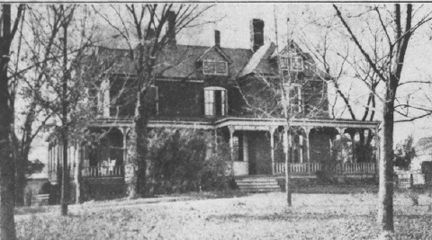
However, working conditions during the Great Depression brought relations between mill workers and management to a boiling point. In September 1934, tens of thousands of textile workers throughout the South walked off the job protesting conditions at the mills and in company-controlled mill villages. According to the News & Observer, hundreds of striking Erwin Mills workers rallied at the Carolina Theatre, marched down Main Street and enjoyed widespread community support. The General Textile Strike of 1934 ended three weeks later with some 20 workers dead from strike-related violence, others sitting in internment camps and little progress for the "lintheads," the pejorative term for cotton mill workers in the Carolinas, Georgia, Tennessee and Alabama. Years later, the memory of the strike (considered by historians the largest labor revolt in Southern history) has faded along with the mill villages it helped eliminate. In a part of the country where "union" often has the status of a four-letter word, the strike showed that Southern workers can organize for change even during the Great Depression and amid the constraints of having the mill as employer, landlord and store owner.
Bill Holmes (owner of The Ideal Sundry on Hillsborough Road) tells us that mill workers and their families were even provided with free cemetery plots at the western edge of the mill village. The Erwin Mills cemetery (aka Cedar Hill) is located in what was then Hickstown. In 1957, Erwin Mills sold the cemetery to the Knights of Pythias for $1.00. The cemetery is still standing on a quiet stretch of West Pettigrew Street (in a grove of forgotten trees behind West Durham Lumber -- between the railroad tracks and the Durham Freeway). The Old West Durham Neighborhood Association organized three cemetery clean-ups to remove several truckloads of underbrush, paint the fence, install two cemetery signs and plant more that 200 daffodil bulbs.
According to E.K. Powe III, "because there was no air-conditioning, everyone sat on the porch after supper until it was cool enough to retire. Another front porch pastime was watching the train go by. There used to be a little wooden station just before the Ninth Street over-pass where passengers could board the train. You would hear the shirk of the whistle when the train was about to arrive."
Powe added that West Durham was also home to "one of the first automobiles in Durham, a Hudson with wide running boards and two spare tires at the front. [one long time resident] remembers her brother hopping out to light the headlights at twilight."
"Powe also described how when his grandfather, E.K. Powe (the mill's first general manager), walked through the mill village...", he would stop to talk to the workers in their yards and on their front porches. He invited them to band concerts in the park. He took them rose bushes to plant in their yards, many of which are still blooming in West Durham today. "When E.K. Powe died in 1929, the school on Ninth Street was named in his honor -- reflecting Powe's concern for the educational needs of the neighborhood children."
Erwin also strictly supervised the mill village, according to Powe. "If he heard that one of the daughters of an employee was acting too amorously with young West Durham men, he would admonish her parents to correct the situation, or be fired!"
This approach quickly put and end to the infamous history of Pin Hook's past. By the time Durham had reached a population of 5,000, Erwin was able to boast, "Moral conditions of my town, West Durham, are better than any in the city."
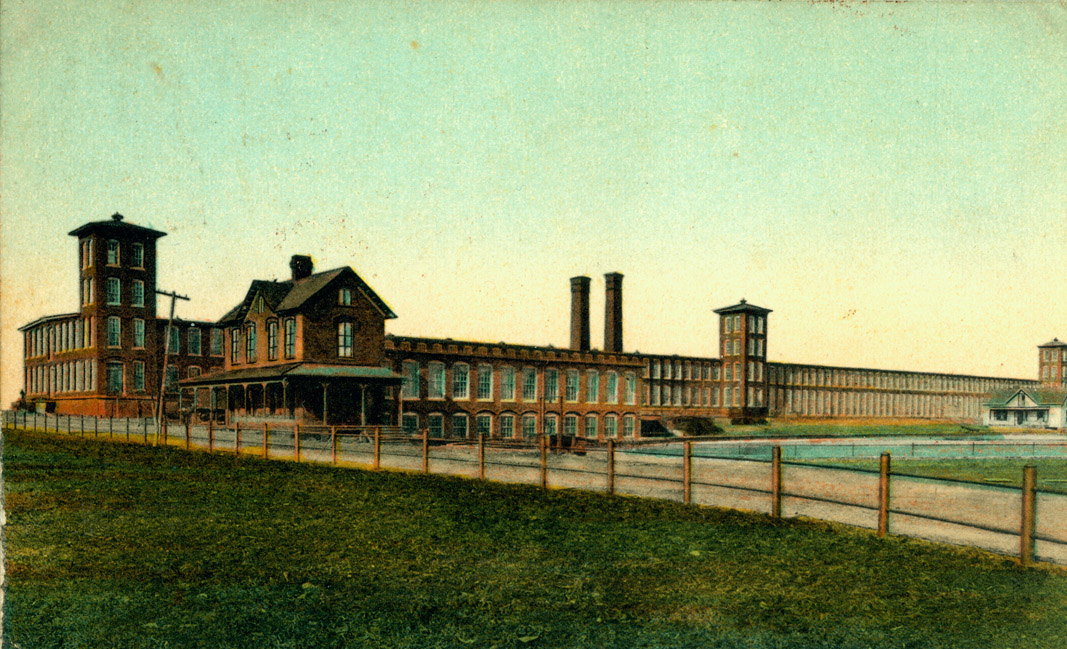
Duke University
About the same time the Erwin Mills were getting started, the eastern edge of Old West Durham was home to a fairground, horse racetrack, stables, and grandstand all known as Blackwell's Park. (According to Powe, a horse raised at Blackwell's named Baxter took third place in the Kentucky Derby).
In the 1880s, the trustees of Trinity College were looking for a new campus and had narrowed its choices to Raleigh or Durham. In 1889, they accepted Durham's offer of 62 acres (at West Main and Broad streets) donated by Julian Carr and $85,000 from Washington Duke. Blackwell's Park had become Trinity College and would eventually become Duke University.
The design of Duke's East Campus largely follows the layout of the original race track. Some of the first football games in the South took place on Duke's East Campus between Trinity College and the University of North Carolina (beginning one of the greatest rivalries in all sports). Later, one of the state's first college basketball game was played in the old Ark on East Campus when Duke beat UNC, 19-18, on January 24, 1920.
The break in the campus wall along Broad Street (by the turf field and row of cypresses) is possibly the old entrance to Blackwell Park and the race-track. Long-time residents remember a brick (not Duke stone) element of the wall along this stretch.
Ninth Street Merchant's District
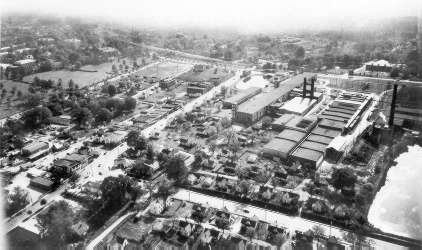
According to the Durham Herald-Sun, Ninth Street saw its first real boom about 1910. Brick facades replaced old, wood-frame buildings on the eastern side of the street. Two groceries, two drugstores, a general store, a boot maker and watchmaker, filling stations, banks and others served more than 1,600 mill workers by the 1920s.
Farther up Ninth Street (previously called Main Street) stands E.K. Powe Elementary School (formally West Durham Graded School No. 2) and the city's oldest fire station. According to retired fire fighter, Wayne Smith, Fire Station #2 was originally located at the Liggett & Myers Tobacco Factory on West Main. The City moved the station further out to get faster response times to fires in the residential areas and nearby schools and hospitals (Duke and Watts). The Ninth Street property was purchased by the City from the heirs of Mrs. Ida Couch for about $7,000. The colonial-designed fire station was built for $165,000 and was described as "one of the most modern fire stations in the South." The station was formally dedicated on September 28, 1950 by Fire Chief Cosmo Cox.
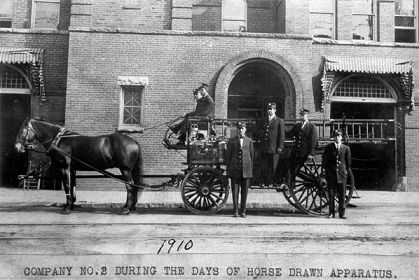
In 1922, McDonald's Drugstore moved to Ninth Street from downtown. By the 1930s, unpaved Ninth Street -- with its pool halls and underpaid factory workers -- could be a rough place. Fights broke out among laid-off men. People were frustrated and had too much extra time according to the Herald-Sun. During the Depression, the Bank of West Durham, next to McDonald's Drugstore, would close its doors for the last time.
After the post-war boom, the 1960s and 1970s brought further changes according to long-time residents. One week after the Couch furniture store was built on Ninth Street in 1968, Dr. Martin Luther King was assassinated and the new store was burned down. The National Guard was called to Ninth Street. (A brick Couch office building now stands on the site of the old furniture store.)
During the 1970s, Northgate Mall opened -- drawing away shoppers. Then Erwin Cotton Mills merged with Burlington Industries and gradually began closing its factory in West Durham. Times had hit rock-bottom.
In 1976, two friends opened an eclectic bookstore on Ninth Street and people thought they were crazy. More than twenty years later, the Regulator Bookshop is the first destination for many Ninth Street patrons. Other early businesses followed including Wellspring Grocery, Ninth Street Bakery, Vaguely Reminiscent, and Francesca's Ice Cream.
The Independent (the Triangle's favorite alternative weekly) started operating out of a small brick and cinder block building at 2824 Hillsborough Road in 1982. The Old West Durham site was chosen because one co-founder had his typesetting business there and the other lived nearby. The early staff of 15 was crammed into an almost windowless building that was shared with the car radio repair folks who are still there today. In 1986, the Independent moved a block up the street to its current location. Indy staff converted the old duplex into an office by poking holes in a couple of walls and building an addition -- over four weekends of sweat. Today, while there are few residences left on Hillsborough, the Indy's next door neighbors have remained -- along with their wonderful garden out back.
In 1986, much of Old West Durham was designated by the U.S. National Park Service as a National Registry Historic District. Places listed on the Register include historic districts that are significant in American history, architecture, archeology, and culture. In addition, several historic properties in Old West Durham have been recognized by the Historic Preservation Society of Durham for excellence in preserving our built heritage. The E.K. Powe house (1503 West Pettigrew) and the Erwin Mills (Ninth Street) are also listed on the National Register of Historic Places. National Register properties are distinguished historic properties worthy of preservation that have been documented to recognize the accomplishments of all peoples who have contributed to the history and heritage of the United States.
Old West Durham recently received local, statewide and national recognition for its efforts to tell the story of its neighborhood history on the Web. OWDNA was honored by the Historic Preservation Society of Durham with the Pyne Preservation Award, by Preservation North Carolina with the Carraway Award and by the U.S. Library of Congress as a "Local Legacy."
Today, the booming Ninth Street area has become one of the Triangle's most popular destinations where visitors, students, and neighbors enjoy a diverse offering of excellent restaurants and eclectic shops in the heart of an old mill village.
Historic Old West Durham remains a collection of quiet, tree-lined streets. Our neighborhood is a place with a colorful past and a bright future. Ours is a place where the front porch is still used for visiting with neighbors, where the train whistle is still appreciated, and where the roses still bloom. This is our home.
Sources: Jean Anderson (author, Durham County), John Ansley (Durham County Library), Debora Antiga (Rome, Italy), Shorty Barnes (Ninth Street), Lois Bennett Ramsey (Blue Light Diner), Paul Bonner (Herald-Sun), Larry Chapman (Watts-Hillandale), Bob Chapman (Trinity Heights) Faye James Cates (long-time resident), Mary Coles (grew up on Ninth Street), Frances Edgerton (Grey Stone Baptist), Betsy Holloway (Watts School),William Erwin & Paul Mangiafico (Duke's Perkins Library), James Eubanks (grew up on Case Street), Nancy Eubanks (Hillsboro Road), Mr. and Mrs. Edward Green (E.K. Powe), Durham Herald-Sun, Holly Marlow Hall (Child of the Mill Village), Duncan Heron (Duke), Tommy Hunt (grew up on Erwin Road), Joe Johnson and Vic Fowler (Erwin Mills No. 2), Alice Eley Jones (Stagville Historic site), Rebecca Dailey Kneedler (Dailey's Store), Bill King (Duke Archives), Linda Lancaster (grew up in West Durham), Irene Maynor (West Durham Pentecostal) John McDonald & Bill Holmes (long-time West Durham business owners), Tom Miller (Historic Preservation Society of Durham), Raleigh News & Observer, Peter Nichol (Boston), John W. Olive (Wilmington, NC), BB Olive (West Durham Airport), E.K. Powe III, Durham Architectural & Historic Inventory (Historic Preservation Society Lynn Richardson (NC Collection, Durham County Library), Pastor Roland Verrico and Janie Baker (West Durham Church of God), Lynn Rumley (Cooleemee Mill Village Museum), Steve Schewel, Wayne Smith (Ninth Street Fire Station), UNC's Southern Historical Collection, David Southern (Duke University Press), Marshall Thompson (Hayti Police), Elizabeth Utley (15th Street). Nadine Wilkins (Alabama Avenue), Lawrence Williams (grew up on Swift Avenue), Jim Wise (News & Observer) Bill Yarbrough (Chesapeake, Virginia)
